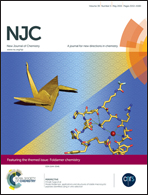A novel nanotube-shaped polypyrrole–Pd composite prepared using reverse microemulsion polymerization and its evaluation as an antibacterial agent†
Abstract
Due to the huge number of applications of polymer–noble metal nanocomposites, a simple synthetic route for the design of polypyrrole nanotubes in the presence of Pd nanoparticles (PPy–Pd) has been reported in this paper. In this method, we synthesized Pd nanoparticles using rosemary extract, as the reducing agent, then combined these with a reverse cylindrical micelle containing the pyrrole monomer and an aqueous FeCl3 solution to produce the nanotube-shaped PPy–Pd composite. The synthesized nanotube PPy–Pd composite was studied using different characterization techniques, such as FTIR, XRD, SEM and TEM. The antibacterial activity of the synthesized nanocomposite was evaluated against clinical isolates of Gram-positive (Bacillus sp. and Staphylococcus aureus) and Gram-negative (Escherichia coli and Klebsiella sp.) bacteria. The Kirby–Bauer method for determination of the inhibition zone and a micro-plate dilution method for investigation of the Minimal Inhibitory Concentration (MIC) and Minimal Bactericidal Concentration (MBC) were accomplished. The obtained results exhibited that the antibacterial activity of the nanocomposite was improved compared with pure polypyrrole due to the existence of the Pd nanoparticles.


 Please wait while we load your content...
Please wait while we load your content...